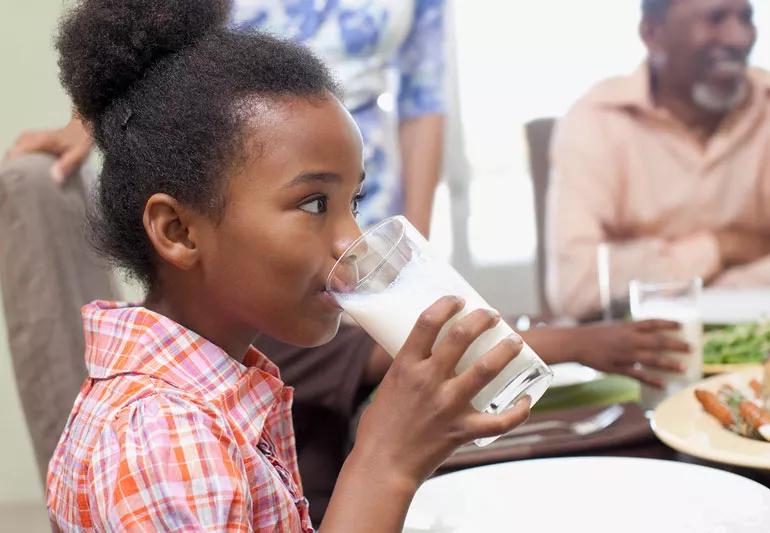Advertisement
Be aware of the signs and symptoms of this digestive problem

By pediatric gastroenterologist Kadakkal Radhakrishnan, MD
Advertisement
Cleveland Clinic is a non-profit academic medical center. Advertising on our site helps support our mission. We do not endorse non-Cleveland Clinic products or services. Policy
If an ice cream treat or a glass of milk leaves your child complaining of an upset stomach, you might wonder if lactose intolerance is to blame.
Children who are lactose intolerant don’t produce enough lactase, a natural enzyme in the digestive tract that breaks down lactose. In order to pinpoint if your child has this issue, it’s important to be aware of the signs and symptoms.
Lactose is a sugar found in foods that many children love, including milk, ice cream and soft cheeses. It’s also present in some baked goods, salad dressings, sauces, candy and other foods you might not expect. Breast milk and infant formulas contain lactose, too.
Lactose is made up of two simple sugar molecules — glucose and galactose. In order for it to be absorbed by the body, lactose has to be split into its two components by an enzyme called lactase, which is found in the lining of the small intestine.
But for those who are lactose intolerant, the activity of lactase is ineffective, and it’s unable to digest and absorb lactose in the small intestine. The lactose then passes into the large intestine, where it is fermented by gut bacteria. This process produces carbon dioxide and hydrogen, as well as certain byproducts that have a laxative effect.
If your child is intolerant, the more lactose they consume, the more symptoms they’ll experience.
Here are some symptoms you should watch out for, especially after your child eats dairy products:
Parents sometimes confuse lactose intolerance with milk allergy. Although the two have similar symptoms, they are very different conditions. A milk allergy is a serious immune system reaction that usually appears in the first year of life. Lactose intolerance is a digestive issue that is rarely seen in infants or toddlers.
Lactose intolerance symptoms can start in late childhood or adolescence, and can become more noticeable into adulthood.
Aside from the discomfort associated with these symptoms, lactose intolerance is a nonthreatening disorder with no long-term complications. Symptoms can be avoided by limiting certain foods in your child’s diet.
Advertisement
Your Practical Guide to Lactose Intolerance
Lactose intolerance can develop in three different ways:
Lactase activity in the small intestine naturally declines after infancy. The National Institutes of Health estimates that as many as two-thirds of people aren’t able to fully digest lactose beyond childhood.
Rarely, babies are born with a complete absence of the lactase enzyme. These babies develop severe diarrhea while on breast milk, forcing them to require special formulas. This is a recessive trait, so the baby must acquire one abnormal gene from each parent to have the symptoms.
Someone can develop a temporary intolerance after an infection that causes irritation of the digestive tract, such as rotavirus or giardiasis. Patients often first have nausea, vomiting and diarrhea, then continue to have diarrhea when consuming lactose-containing foods for some time after the infection has cleared.
Celiac disease, a digestive disorder that causes damage to the small intestine when gluten is ingested, can also be associated with temporary lactose intolerance. Those with celiac disease can tolerate lactose-containing foods once the intestinal lining heals after going on a strict gluten-free diet. Crohn’s disease, an inflammatory disorder of the bowel, also can be associated with lactose intolerance. This often improves once adequate treatment is in place.
It’s quite easy to test for lactose intolerance. It’s done using a lactose breath test, which measures hydrogen levels in the breath after consuming lactose.
Normally, very little hydrogen is detected in breath. Raised hydrogen breath levels indicate the improper digestion of lactose, which could indicate lactose intolerance. In young children and those who cannot perform the breath test, strict elimination of lactose-containing food for two to four weeks is another option.
Although there is no cure for this digestive problem, some dietary changes can make a huge difference for your child. I also recommend children with lactose intolerance take an over-the-counter lactase enzyme supplement if they are going to eat any lactose-containing foods to help alleviate symptoms. However, this may not help if consumed with large amounts of lactose-containing foods.
Over time, you and your child will learn how much dairy-based food and drink they can handle. For patients with significant symptoms, a dietitian can help identify foods containing lactose.
It is also important to make sure your child still gets enough calcium and vitamin D, since dairy is normally a good source for these nutrients.
Advertisement
Learn more about our editorial process.
Advertisement

Setting specific expectations and praising good behavior are crucial to cultivating discipline

‘Active shooter’ exercises may raise both awareness and anxiety

Burping, gas drops and extra tummy time are just a few ways to help your wee one rip one

Stay calm, don’t give in and try to refocus their attention

Integrating coping skills into your teen’s daily routine helps turn self-care into a lifelong healthy habit

Tantrums and meltdowns are normal, but you can help your child manage their bigger emotions

Talking in the car, resisting the urge to judge and asking specific questions can help rebuild rapport

Yes, it’s safe for babies starting at about 9 months old and can help clear nasal mucus

Focus on your body’s metabolic set point by eating healthy foods, making exercise a part of your routine and reducing stress

PFAS chemicals may make life easier — but they aren’t always so easy on the human body

While there’s little risk in trying this hair care treatment, there isn’t much science to back up the claims